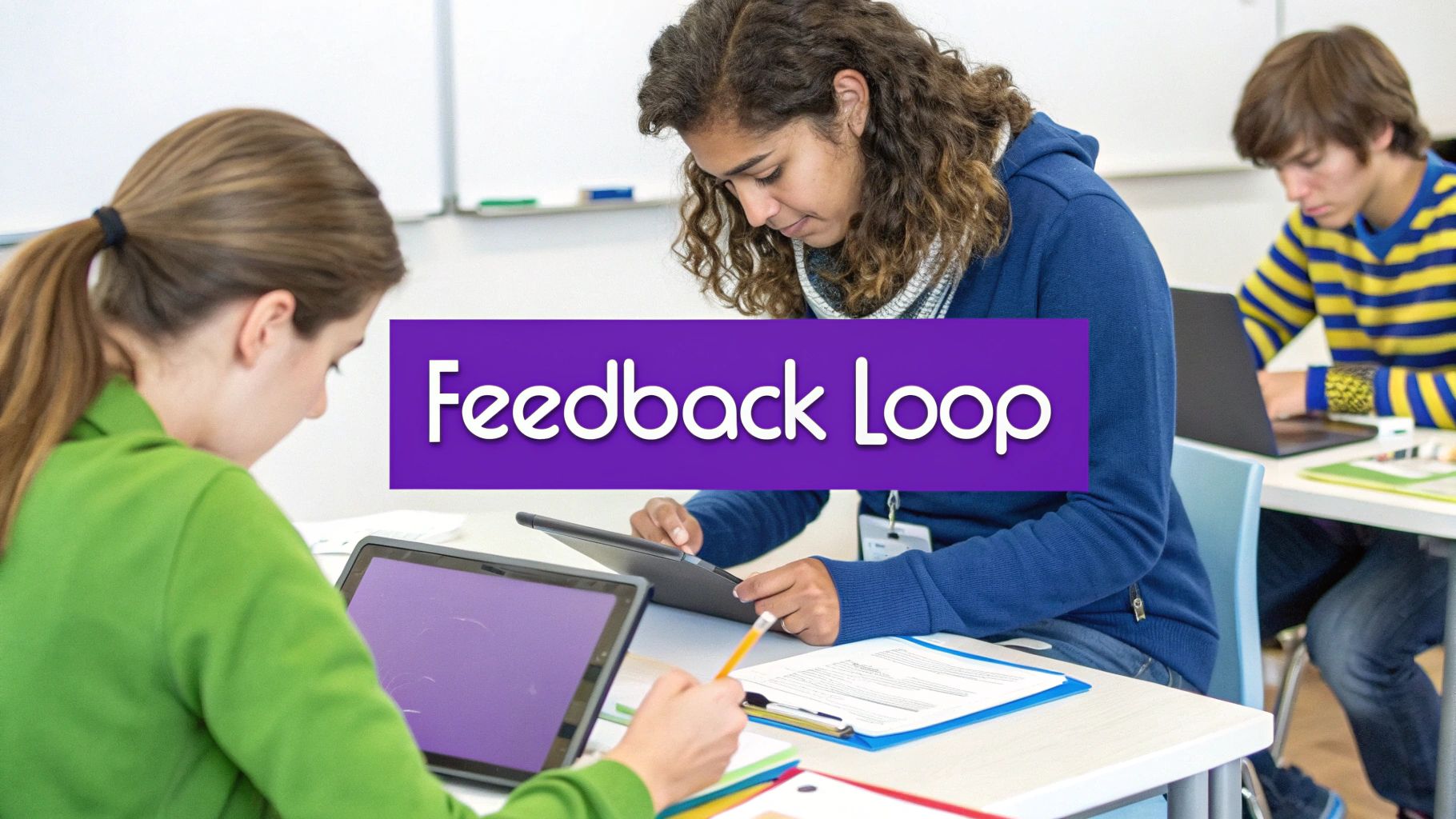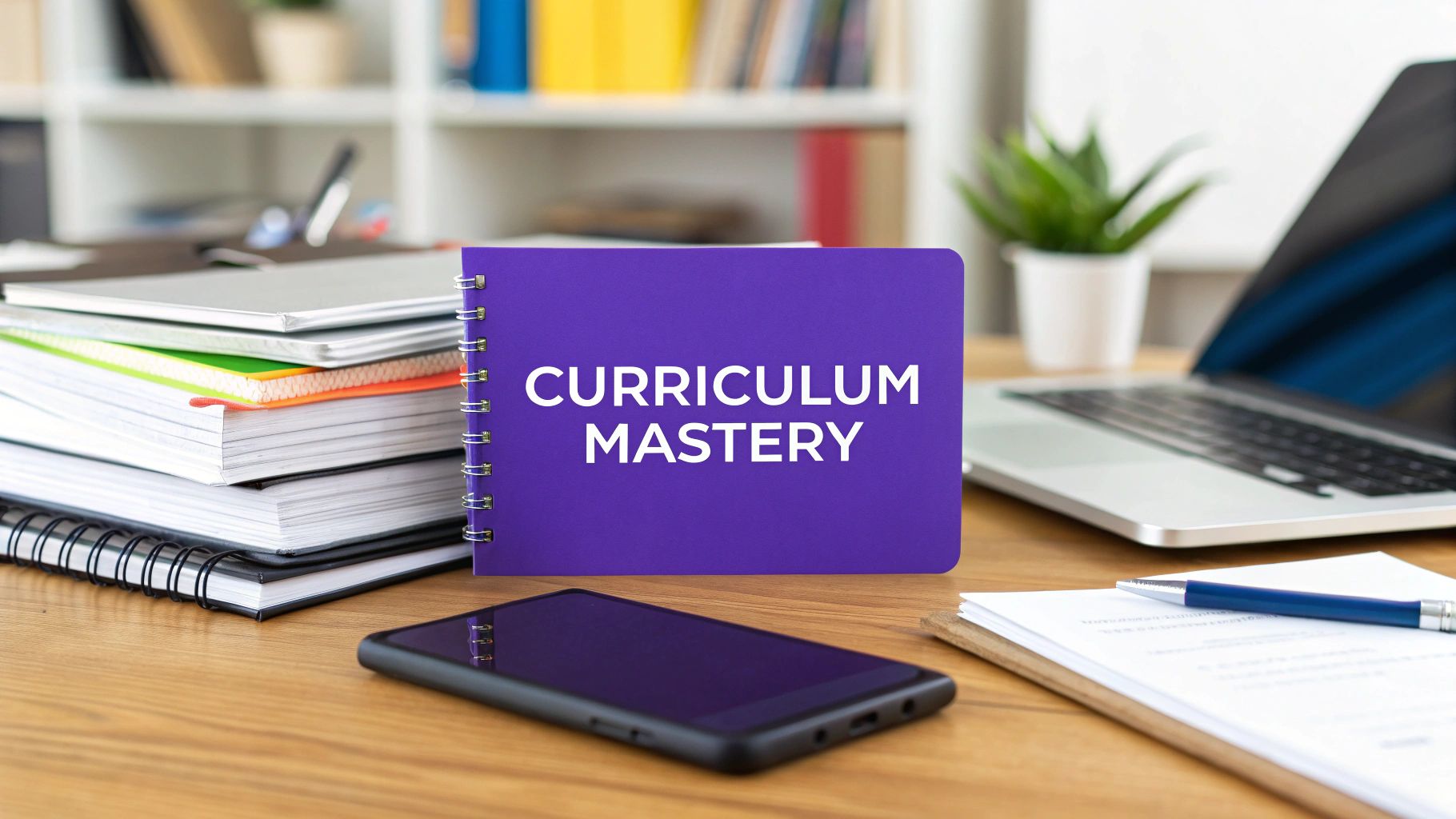The Foundations of Effective Curriculum Design
Before diving into the specifics of curriculum writing, it's crucial to understand the core components of what makes a curriculum effective. This involves understanding the differences between key educational tools: the curriculum, the syllabus, and the lesson plan. These distinct elements work together within a broader educational structure. A curriculum provides the overarching framework, outlining learning goals and the general content for a program of study. This sets the stage for more detailed planning.
Building upon the curriculum is the syllabus. Consider the syllabus a roadmap for a specific course within the curriculum. It gives students a detailed overview of course content, schedule, grading policies, and expectations. In essence, the syllabus puts the curriculum into action for a specific course. Finally, lesson plans break down the syllabus into individual learning experiences. They outline the activities, materials, and assessments for each class period, bringing the curriculum and syllabus to life in the classroom.
Essential Components of Curriculum Design
Effective curricula share some key characteristics. These vital components contribute to impactful learning. First, clear learning objectives define what students should know and be able to do after completing the curriculum. These objectives guide instruction and assessment. A well-defined scope and sequence ensures the content is organized logically, building upon previous learning. This structured approach avoids knowledge gaps and encourages deeper understanding.
Relevant and engaging content is also crucial. It should align with student needs and connect to real-world applications. Project-based learning, for example, allows students to apply knowledge to practical scenarios, making learning more relevant. Diverse instructional strategies cater to different learning styles and keep students actively involved. This can include discussions, group work, presentations, and integrating technology.
Historically, curriculum development has occurred on both local and global levels. The growth of international schools, for instance, has led to significant adoption of programs like the International Baccalaureate (IB) and Cambridge International. Over 1,500 schools worldwide offer the IB curriculum alone, reflecting a trend towards internationalizing education. You can find more detailed statistics from ISC Research. All these components work together to create a robust learning experience, forming the basis of successful curriculum development. Understanding these foundational principles is essential for building a curriculum that engages learners and fosters their growth.
Research That Actually Improves Your Curriculum

A well-crafted curriculum isn't built on guesswork. It requires solid research to ensure its effectiveness. This means understanding your learners, your institution's requirements, and the industry standards you're preparing students for. This research informs design decisions, leading to relevant and impactful learning experiences.
Understanding Your Learners Through Needs Assessments
Conducting a needs assessment is crucial for curriculum development. This process helps identify existing knowledge gaps and pinpoint areas where your curriculum can add the most value.
For example, are there specific skills learners consistently struggle with? Are there emerging industry trends that require curriculum adjustments? A needs assessment helps answer these questions.
The goal isn't to confirm assumptions about learner needs. Instead, it's about gathering objective data. Surveys, interviews, and analyzing existing performance data can provide valuable insights into learner needs and preferences. These insights help shape a truly learner-centered curriculum.
Research Methods for Actionable Data
Different educational contexts benefit from various research methods. Qualitative research methods, like focus groups, provide an in-depth understanding of learner experiences.
Quantitative research, using surveys and data analysis, reveals trends and patterns in larger learner populations. This allows you to adapt your curriculum based on concrete evidence.
Staying informed about industry standards is also essential for a relevant curriculum. This includes researching current job market demands and emerging trends. This ensures the skills and knowledge your curriculum provides will be valuable to learners’ future careers.
Using data in curriculum design is increasingly significant. Educational institutions are employing statistical methods to inform decisions, improving student outcomes. For example, schools implementing data-driven reforms have seen a 27% improvement in student learning compared to traditional approaches. Explore this topic further at Number Analytics.
Balancing Idealism with Practical Constraints
While research is invaluable, balancing research findings with practical constraints is equally important. Curriculum developers often face limitations in resources, time, and instructor expertise.
This means making strategic decisions about which research aspects to prioritize. It involves finding creative solutions that maximize impact within existing limitations.
This might mean adapting existing resources, seeking out open educational resources, or using technology to enhance learning experiences.
Crafting Learning Objectives That Drive Results

Learning objectives form the foundation of any successful curriculum. They act as a roadmap for both instructors and students, clearly outlining the intended learning outcomes. However, poorly written objectives can hinder the educational journey. This section explores how to create effective learning objectives that truly drive results.
Writing SMART Learning Objectives
Effective educators use the SMART framework for crafting learning objectives: Specific, Measurable, Achievable, Relevant, and Time-Bound. This framework provides clarity and sets a tangible target for learning. A specific objective clearly articulates what students should be able to do, avoiding vague terminology. Measurable objectives define criteria for evaluating whether the objective has been met, allowing for progress tracking and feedback.
Achievable objectives are realistic within the given timeframe and available resources. Relevant objectives align with the overall curriculum goals and meet learner needs, ensuring the content is purposeful. Finally, time-bound objectives specify a deadline for achievement. This adds a sense of urgency and helps maintain momentum. Learn more in this article about top learning objectives examples to boost teaching.
Using Bloom’s Taxonomy
Bloom’s Taxonomy is a practical framework for developing objectives that target different cognitive levels. This hierarchical model categorizes learning objectives into six levels, from basic recall (Remembering) to complex higher-order thinking (Creating). Aligning objectives with Bloom’s Taxonomy helps ensure your curriculum promotes deep learning and critical thinking.
The following table provides more detail about Bloom's Taxonomy and its practical application:
Bloom's Taxonomy Levels for Curriculum Objectives
This table provides examples of action verbs corresponding to different cognitive levels in Bloom’s Taxonomy, helping curriculum developers craft appropriate learning objectives.
| Cognitive Level | Definition | Action Verbs | Example Objective |
|---|---|---|---|
| Remembering | Retrieving relevant knowledge from long-term memory | List, Define, Recall, Identify | Students will be able to list the three branches of government. |
| Understanding | Constructing meaning from instructional messages | Explain, Summarize, Paraphrase, Interpret | Students will be able to explain the process of photosynthesis. |
| Applying | Carrying out or using a procedure through executing or implementing | Apply, Solve, Use, Demonstrate | Students will be able to apply the Pythagorean theorem to solve right triangle problems. |
| Analyzing | Breaking material into constituent parts, determining how the parts relate to one another and to an overall structure or purpose | Analyze, Differentiate, Organize, Compare | Students will be able to analyze the themes present in Shakespeare's Hamlet. |
| Evaluating | Making judgments based on criteria and standards | Evaluate, Critique, Justify, Assess | Students will be able to evaluate the effectiveness of different marketing strategies. |
| Creating | Putting elements together to form a coherent or functional whole; reorganizing elements into a new pattern or structure | Create, Design, Develop, Compose | Students will be able to create a marketing plan for a new product. |
This table illustrates how Bloom's Taxonomy can be used to create objectives that challenge students at different levels of thinking. By using action verbs associated with higher cognitive levels, educators can encourage deeper learning and critical thinking skills.
Aligning Objectives, Content, and Assessments
Well-defined objectives are more than just statements of intent; they are the driving force behind a coherent curriculum. They create alignment between the content delivered, the learning activities, and the assessments used to measure progress. For example, if an objective focuses on applying a concept, both the activities and assessments should give students opportunities to demonstrate that application. This interconnectedness strengthens the learning experience.
This alignment ensures all elements of the curriculum work together, promoting genuine understanding and skill development. You might be interested in top learning objectives examples to boost teaching. This focused approach ensures that the curriculum is not just a collection of information but a structured pathway to meaningful learning outcomes. This interwoven approach ensures that the curriculum is a guided path towards meaningful outcomes.
Building a Learning Sequence That Actually Works

A well-structured curriculum isn't simply a checklist of topics; it's a thoughtfully designed learning journey. This involves organizing your content to guide learners from basic concepts to more advanced skills, ultimately achieving true mastery. Expert curriculum developers excel at transforming fragmented information into a cohesive and engaging learning experience. How do they accomplish this? Let's delve in.
Practical Approaches to Content Structuring
Several approaches exist for structuring curriculum content, each tailored to specific subjects and learning preferences. A chronological approach, often used in history or literature, presents information in a time-based order. This helps learners understand the development of events or the evolution of ideas over time.
Alternatively, thematic organization groups content around core themes or topics. This method excels in interdisciplinary studies or project-based learning, facilitating the exploration of connections between different subject areas.
A conceptual approach emphasizes fundamental concepts and principles, progressively building upon these foundations. This is particularly effective for math or science, where a strong grasp of core ideas is crucial for tackling complex problems. Problem-based learning presents another powerful strategy, challenging learners to apply their knowledge and skills to solve real-world issues. This fosters critical thinking and practical problem-solving abilities.
Determining Scope and Depth
A significant challenge in curriculum design lies in determining the appropriate scope and depth of the content. Too much information can overwhelm learners, while superficial coverage hinders true understanding. Striking the right balance is key to creating effective learning experiences.
Imagine building a house. You wouldn't begin with the roof before laying the foundation. Similarly, a curriculum should start with foundational concepts and gradually introduce more advanced material. This scaffolded approach provides essential support, ensuring learners master each step before progressing. Read also: How to Master Your Sequence of Learning.
Creating Scaffolded Learning Experiences
Scaffolding involves breaking down complex skills into smaller, more manageable steps. Consider teaching writing. A scaffolded approach might start with sentence construction, progress to paragraph writing, and finally culminate in essay composition. Each stage builds upon the previous one, reinforcing learning and preparing learners for increasing complexity. This method cultivates genuine mastery rather than superficial understanding.
Building Towards Mastery
The ultimate aim of a well-designed curriculum is to empower learners to achieve mastery. This signifies a deep understanding of concepts and the ability to apply that knowledge across diverse contexts. By employing a structured, scaffolded approach, you can create a learning sequence that not only covers the required content but also equips learners with the confidence and competence to thrive in their chosen field. This preparation for future challenges and opportunities is the pathway to lasting success.
Selecting Teaching Methods That Deliver Results
A well-designed curriculum relies heavily on the chosen teaching methods. Picking the right approach is crucial for achieving learning objectives. This careful selection involves analyzing various methodologies and aligning them with specific learning contexts and goals. This is where the true art of curriculum design lies.
Matching Methods to Objectives and Context
Just as a craftsman selects the perfect tool, curriculum developers must choose teaching strategies that effectively address their learning objectives. For instance, direct instruction, emphasizing clear explanations and structured practice, works well for introducing new concepts. However, for objectives focused on critical thinking, inquiry-based learning, which encourages exploration and discovery, might be more appropriate. This active learning fosters a deeper understanding. Check out our guide on how to create engaging online courses.
The learning environment also matters. A collaborative project suits a small seminar but might be difficult in a large lecture hall. The students' age and background are also important factors. Younger students often benefit from hands-on activities, while older learners might prefer discussions. A varied approach ensures the curriculum caters to diverse learning styles and provides a well-rounded experience.
To help illustrate the differences between various instructional approaches, the following table provides a comparison across several key criteria. This will assist in choosing the best method for your specific learning environment and objectives.
Comparing Instructional Approaches for Curriculum Design This table compares different teaching methodologies across key criteria to help curriculum developers select appropriate approaches for their educational context.
| Instructional Approach | Best Suited For | Teacher's Role | Student Engagement | Resource Requirements | Assessment Compatibility |
|---|---|---|---|---|---|
| Direct Instruction | Foundational skills, introducing new concepts | Delivering information, guiding practice | Active listening, practicing skills | Textbooks, worksheets, presentations | Traditional assessments, quizzes, tests |
| Inquiry-Based Learning | Critical thinking, problem-solving, research skills | Facilitating exploration, guiding discovery | Active investigation, collaboration | Research materials, technology, open-ended tasks | Project-based assessments, portfolios, presentations |
| Project-Based Learning | Real-world application, collaboration, creative problem-solving | Guiding project development, providing feedback | Active participation, teamwork, project management | Project materials, technology, collaborative spaces | Project evaluations, presentations, peer feedback |
| Cooperative Learning | Social skills development, teamwork, peer learning | Structuring group activities, monitoring progress | Active collaboration, peer support, shared responsibility | Group workspaces, collaborative tools | Group presentations, peer evaluations, individual contributions |
| Discussion-Based Learning | Critical analysis, communication skills, exploring diverse perspectives | Facilitating discussion, guiding critical thinking | Active participation in discussions, sharing ideas, respectful debate | Discussion prompts, comfortable environment | Participation grades, reflective essays, presentations |
Key takeaways from this comparison include the importance of aligning the instructional approach with learning objectives and the varying levels of student engagement and resource requirements associated with each method. Careful consideration of these factors will lead to a more effective curriculum.
Creating a Balanced Approach
The most effective curricula rarely stick to one teaching method. Instead, they use a mix of strategies to engage different learners and achieve various learning objectives. This keeps students motivated and caters to different learning preferences. This might mean combining direct instruction with group work, projects with individual research, or online simulations with hands-on experiments. This balanced approach promotes critical thinking and problem-solving skills.
Practical Considerations: Resources, Time, and Expertise
While ambition is important, practical limitations influence curriculum development. Resources, time, and instructor expertise play a role in selecting appropriate teaching methods. A resource-intensive project might be unrealistic with a limited budget. Complex teaching strategies may require instructor training and ongoing support. A curriculum must work within these constraints to be implemented and maintained effectively.
Transforming Learning Through Effective Teaching
The right teaching methods transform a static curriculum into a dynamic learning experience. By strategically choosing teaching methods that align with objectives, context, and resources, students can engage deeply with the material, develop key skills, and achieve lasting mastery. This approach goes beyond simply covering content and empowers learners. The goal is to create learning experiences that are engaging, relevant, and truly transformative.
Creating Assessments That Measure What Matters
Assessment is an integral part of any curriculum. It's not something you tack on at the end. Instead, it should shape student learning and offer valuable feedback. Effective curriculum developers understand this and build authentic assessments. These assessments accurately measure student achievement while also encouraging deeper learning. This involves carefully balancing different assessment approaches and ensuring they align with your learning objectives.
Balancing Formative and Summative Assessments
Formative assessments are like checking in as you go. These assessments, such as quizzes or in-class discussions, provide ongoing feedback during the learning process. Think of it like checking a recipe as you cook. This approach enables instructors to identify areas where students might be struggling and adjust their teaching accordingly.
Summative assessments, on the other hand, are like the final taste test. These assessments, like final exams or projects, evaluate learning at the end of a unit or course. They give a snapshot of overall student learning and are often used to inform grading decisions.
A well-rounded assessment strategy includes both formative and summative methods. This dual approach provides a comprehensive picture of student progress, allowing for in-the-moment adjustments and an overall evaluation of achievement.
Traditional vs. Performance-Based Evaluations
Traditional assessments, such as multiple-choice tests, primarily measure knowledge acquisition. While valuable for assessing facts, they often miss the mark when it comes to measuring the application of skills.
Performance-based assessments, such as presentations or projects, require students to demonstrate their skills and apply knowledge in real-world situations. This approach gives a more authentic view of student capabilities and promotes deeper learning. Think of it like learning to ride a bike; a written test won't prove you can ride. You need to show you can actually balance and pedal.
Effective curricula frequently incorporate both traditional and performance-based evaluations. This assesses both knowledge and its application, providing educators with a more complete understanding of student learning.
Aligning Assessments with Learning Objectives
Your assessments should always align with your learning objectives. This ensures you’re measuring what you intend students to learn. This connection strengthens the learning focus. If a learning objective emphasizes problem-solving, the assessment should also require students to solve problems. This clear link makes learning more focused and impactful.
Designing Assessments for Deeper Learning
Assessments should do more than just measure knowledge; they should also encourage critical thinking and practical application. This approach fosters deeper learning. For example, instead of asking students to simply define a term, challenge them to apply the concept to a real-world scenario or analyze its implications.
Practical Considerations: Rubrics, Workload, and Validity
Clear rubrics, especially for performance-based assessments, are essential. They provide specific criteria for evaluation, making assessment fairer and more transparent.
Managing workload is another key consideration. Overly burdensome assessments can create unnecessary stress for both instructors and students. A balanced approach is vital.
Finally, ensuring validity – that assessments accurately measure what they intend to – is crucial. Regularly reviewing and refining your assessments ensures they remain effective and relevant. This continuous improvement process helps optimize assessment design and implementation.
Designing for a Connected, Changing World
A truly effective curriculum doesn't just prepare students for today's realities; it equips them for a future defined by constant evolution. This means weaving global perspectives, cultural responsiveness, and social awareness into the curriculum's core structure. How can educators achieve this? Through thoughtful design and collaboration with forward-thinking colleagues.
Addressing Contemporary Challenges Through Curriculum
Today's challenges, like technological advancements, environmental sustainability, and social justice issues, should be integrated into the curriculum. Imagine a science curriculum exploring the impacts of climate change and empowering students to brainstorm solutions. Or a social studies curriculum examining social movements and their societal influence, fostering critical thinking about social responsibility. This approach helps students understand and analyze global issues, preparing them to be engaged citizens.
Balancing Local Relevance With Global Applicability
Addressing global concerns is crucial, but so is maintaining local relevance. A curriculum should connect global concepts to students' immediate surroundings. A lesson on water conservation could explore both global water scarcity and local water usage practices. This makes learning more meaningful by demonstrating how global issues directly affect local communities.
This localized approach fosters a sense of responsibility and empowers students to apply their knowledge within their communities. This balance ensures the curriculum remains relevant and engaging for every learner.
Developing Adaptable Skills for a Changing World
The rapid pace of change demands adaptable skills, such as critical thinking, problem-solving, and collaboration. These skills enable learners to navigate uncertainty and adapt to new situations. A curriculum focused on these skills might incorporate project-based learning, encouraging teamwork and problem-solving. It could also include opportunities for independent research, fostering critical thinking and information literacy.
Globally, curriculum development is often shaped by social and economic factors. Escalating global conflicts and geopolitical tensions, for example, have significant implications for education systems. These conflicts frequently strain public spending, diverting resources from education to defense and security, as highlighted by the OECD. Find more detailed statistics here.
Creating Future-Ready Learners
Preparing students for the future goes beyond mastering today's requirements. It means equipping them with the skills and mindsets to embrace lifelong learning. This involves fostering a love of learning and the ability to adapt to emerging challenges. A curriculum that promotes lifelong learning could include opportunities for self-directed learning, enabling students to explore their passions. It could also incorporate reflective practices, encouraging students to evaluate their learning journey and identify areas for growth. By prioritizing adaptability and a growth mindset, we can create learners who are truly future-ready.
Ready to build a thriving online learning community and boost your Shopify store's revenue? Explore the powerful features and seamless integration of Tevello today!




